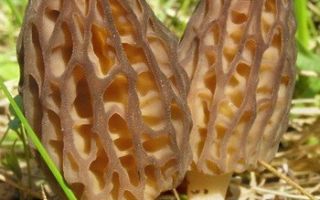Content
For lovers mushrooms you need to know what the benefits and harms of morels are. How and where to pick these mushrooms when the season is to pick them. And most importantly: how to distinguish useful morels from dangerous lines.
What morel mushrooms look like
Morel is one of the most famous forest mushrooms in the world. They are not grown on farms, so they can only be found in the wild. The part we eat is the fruiting body of an underground organism called mycelium. It has complex symbiotic relationships with trees.
The genus of morels has been the subject of controversy and debate for centuries. Mycologists to this day cannot agree on how many subspecies of this genus exist in nature. However, everyone can agree that they are delicious, nutritious, and also healthy.
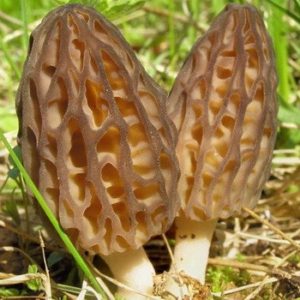
Mushrooms are very different in appearance from each other: their shape varies from oblong to bulbous, color - from white to dark gray. The size can be different, both with a finger and a larger palm. As you can see from the photo, all edible morel mushrooms have common features in appearance: numerous wrinkles or "ridges" on the outer surface. They are dense or loose, and always form an imperfect pattern. The inside of the mushroom is hollow and light and has a goose bone-like texture. The base of the cap is attached to a snow-white stem, which can be either short or long.
The product is popular for its taste and health benefits. Even people who say they don't like mushrooms often rate morel taste as pleasant, although the texture of the mushrooms seems slippery, slimy and unpleasant to them. However, morels are unique as they have a fleshy flesh and a nutty flavor. In nature, there is only one morel-like mushroom: the conditionally edible line.
Morel common
The common (white) subspecies can have a variety of colors, from rich yellow to gray-white. The mushroom has a strong specific aroma. This variety is the most popular in cooking: its beneficial properties have long been proven. They grow throughout the season, which usually lasts from April to June.
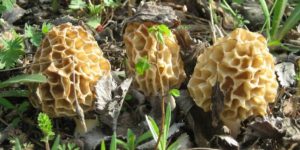
Morel edible
Morel is sometimes called edible. As noted above, it is one of the most recognizable in this family. Its body looks like a densely compressed grayish or yellowish sponge with large pits and ridges attached to a large white stem. The caps can have a diameter of 2 - 7 cm and connect to the stem at its lower edge, forming a continuous void. The wrinkles are round and irregular.
It can be found in old gardens and forests on damaged soil and burned areas. Since the benefits of the product are well known, the hunt for it begins at the beginning of the season.
Morel conical
The conical (black) morels start growing first at the start of the season.They can be large. The black subspecies should be eaten with caution due to its specific properties, as it can cause allergic reactions and upset stomach. When trying them for the first time, it is best to eat small amounts and refrain from alcohol. They are also called gray morels because they start to grow light, turning black as they mature. Mushrooms have an elongated conical shape. Like other varieties of morels, the cap has many wrinkles and fits snugly against the stem. It has a light shade ranging from creamy yellow to white.

Chemical composition and calorie content of morels
The intense nutty aroma of morels attracts the attention of both amateurs and professional chefs. The short harvesting season means the product is difficult to obtain.
The benefits and dangers of morel mushrooms are still debated.
They are worth looking for and collecting not only because of their pleasant taste, but also because of their unique chemical composition and benefits. These mushrooms are a good source of minerals and vitamin D. One glass of raw food can contain 22% of the recommended daily amount of this vitamin. The calorie content is only 31 kcal per 100 grams.
Morels tend to grow in rich soils, which is why they are so packed with vitamins and minerals. The chemical composition can vary, but mushrooms usually contain significant amounts of iron, copper, manganese, phosphorus, zinc, folate, niacin and riboflavin, the benefits of which are beyond question. In addition, they contain a considerable amount of potassium, magnesium, calcium, selenium, thiamine, vitamins E and B6. All this speaks of their undoubted useful properties.
Why morels are useful for the body
In addition to the above substances, morels contain antioxidants and also regulate blood sugar levels and repair liver cells. They are high in protein and fiber, which is invaluable in terms of health benefits.
They are believed to improve appetite and normalize digestion. The vitamins in mushrooms help maintain good vision. They are also useful for strengthening the immune system.
Traditional medicine recipes from morels
Research results have shown that polysaccharides from morel fruit bodies have many medicinal properties, including antitumor, immunoregulatory, and antiviral effects. Extracts from them have, among other things, antioxidant properties.
Morels are used in folk medicine to treat indigestion, excessive sweating, and shortness of breath. For this purpose, a decoction or tincture of mushrooms is used for a long time, the beneficial properties of which are obvious.
Morel juice
It is believed that morel juice is able to benefit the body, providing a healing and tonic effect. You can get it by preparing a concentrated mushroom broth. This is done simply. The proportion is calculated as follows: for each glass of water there should be a tablespoon of chopped mushrooms. The mixture is boiled for half an hour, after which it is left for several hours. The finished broth should be filtered and taken in small quantities (no more than 50 ml at a time).
Alcohol tincture on morels
The tincture is used externally for medicinal purposes. To prepare it, you will need the following:
- dried chopped mushrooms;
- absolute alcohol;
- purified water;
- glycerin of vegetable origin.
The dried chopped mushrooms are divided into two equal portions. After that, half the mushrooms are covered with a mixture consisting of 70% alcohol, 20% glycerin and 10% water. Insist 4-6 weeks.
Then a decoction is prepared by mixing the second half of the mushrooms with a volume of water twice as large as that used in the previous step. Boil it for at least one, preferably two or more hours, adding water as needed during cooking.After that, you need to continue boiling until the liquid begins to evaporate. It should remain exactly the same as the alcohol solution. After that, the broth is removed from the heat and completely cooled.
It is necessary to mix the liquids from the decoction and tincture, while the final product should contain about 25% alcohol. A useful traditional medicine is ready!
Where and when to collect morels
The main feature of morels is that they only appear for a short period each year, usually from April to May. They grow very quickly, almost instantly.
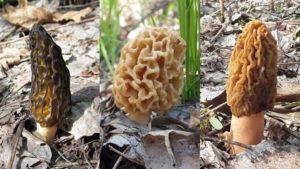
Mushroom pickers can start searching when daytime temperatures are set at 15-20 degrees, nighttime temperatures are at least +5 degrees. Soil temperature also plays a role: for optimal growth of morels, it should be 4-10 degrees.
Morels tend to grow around ash. Most often they can be found under trees (poplars, elms, maples), especially those dying or recently dead. Such interesting properties are simply explainable: most of the fungus is underground, and the mycelium begins to actively multiply when something threatens its ecosystem.
Morels and stitches: differences
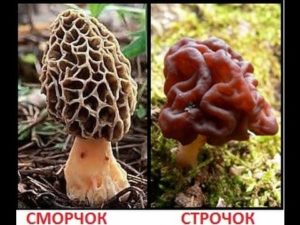
Many have probably heard of "false morels". This term includes a number of different types, including stitching. They are most often mistaken for edible delicacies from the morel genus. As you can see in the photo, it is not easy for an unprepared mushroom picker to distinguish lines and morels.
However, the stitches are poisonous and contain the chemical monomethylhydrazine (MMH). This substance causes vomiting, dizziness, diarrhea, and sometimes even death. It is believed to be carcinogenic. The harm of lines does not even cause controversy.
How to distinguish lines from morels in order to protect yourself from harm? Most of them appear in spring and summer and grow right on the ground. Their caps, usually brown or reddish-brown, have a wavy or lobed structure and seem to protrude outward. True morels have a more uniform cap with wrinkles or ridges. Visually, it seems that they are bent inward rather than bulging.
The cap of the line is located free from the stem, in the morel it is attached to it. When the morel is cut from top to bottom, it will be hollow on the inside. The stitching is filled with fine fibers. Thus, with due care, the lines and morels can be distinguished. According to the criterion of benefit and harm, these mushrooms are antipodes to each other, therefore, picking mushrooms must be taken seriously.
How to cook delicious morels
Morels are best just sautéed in oil. Dried morels are prepared with the addition of a portion of the water in which they were soaked. You can also add some wine or cream.
For the best flavor extraction, it is best to cook over low heat. This seemingly simple dish should be savored.
Some people prefer fried, breaded, stuffed mushrooms, and so on. In fact, the possibilities for a chef are endless!
How to dry morels
Fresh morels are quite brittle and may crumble during handling, peeling and cooking. Dried morels are easier to handle. They soak quickly, do not crumble, and are much easier to stuff.
Drying is a whole art. All it takes is time, air flow and heat. If the weather is warm and sunny for a long time, you can dry the mushrooms naturally: you should put morels on a surface in a well-ventilated place and turn them over from time to time.
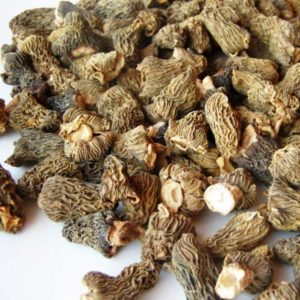
Conclusion
Having found out what are the benefits and harms of morels, one can confidently draw a conclusion about their undoubted culinary and medicinal value. However, the wild product must be properly identified.To distinguish these mushrooms from the lines, which, instead of being beneficial, can cause significant harm to the body, preliminary preparation is needed.
Raw mushrooms should never be consumed as they can cause cramps or indigestion. Cooking removes substances that can cause harm. The first sample of edible morels should be small, with a break of several hours: if there is no allergic reaction, you can eat more.

